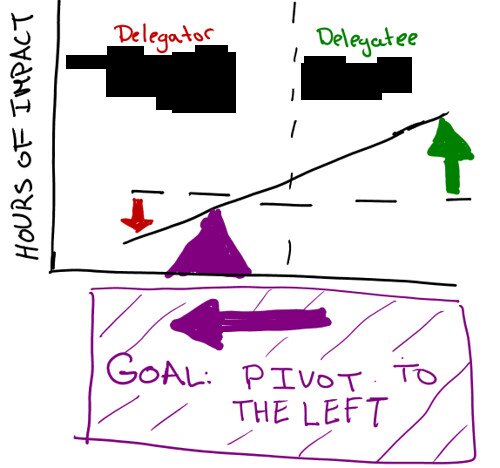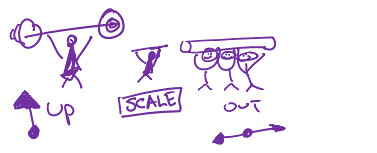 A key scale out skill is delegation. Effective delegation refers to a small negative impact to the delegator resulting in a large positive impact via the effort of the delegatee. Maximum delegation efficiency occurs in stewardship delegation. Stewardship delegation empowers the delegatee to be responsible for the delegated task, and takes an initially large investment from the delegator. However, once the stewardship delegation relationship has been established, minimal effort is required by the delegator to maintain the impact of the delegatee.
A key scale out skill is delegation. Effective delegation refers to a small negative impact to the delegator resulting in a large positive impact via the effort of the delegatee. Maximum delegation efficiency occurs in stewardship delegation. Stewardship delegation empowers the delegatee to be responsible for the delegated task, and takes an initially large investment from the delegator. However, once the stewardship delegation relationship has been established, minimal effort is required by the delegator to maintain the impact of the delegatee.A delegation relationship can be modelled as a teeter totter with the delegator on the left and the delegatee on the right. The effectiveness of the delegation can be thought of as the pivot location. To increase the effectiveness of the delegation, the pivot must be moved to the left which allows small effort by the delegator to enable large impact via the delegatee.
The pivot location and its movement is a function of delegation style. At the extreme of delegation styles is gopher delegation and stewardship delegation. Gopher delegation keeps the responsibility for the task with the delegator and involves telling the delegatee extremely prescriptive tasks e.g. go for this, go for that. Stewardship delegation transfers the responsibility for the delegated task to the delegatee and requires the delegator explaining the end result and the operating principles of the delegated task to the delegatee.
At the start of gopher delegation the teeter totter pivot starts at the left of center with the delegator's cost less than the gains achieved through the work of the delegatee. This makes the delegator effective from the start, and seems great. However, over time as the delegatee does tasks wrong, as the delegated tasks start having complications, and ultimately as the delegatee gets bored and disengaged, the pivot begins to move the to the right. After a while, gopher delegation results in a pivot right of center, and the delegation ends up being ineffective. Eventually, more time is required from the delegator then is gained from the actions of the delegatee and thus gopher delegation is best used for short lived scoped tasks.
At the start of stewardship delegation, the teeter totter pivot starts very far to the right. Significant time needs to be spent to engage the delegatee. The delegatee needs to understand the desired result, the operating parameters, and ultimately needs to be feel empowered and responsible. Over time, as the delegatee understands her role and its responsibilities the pivot begins to move to the left, but the delegator still requires large investment as she must provide feedback and encouragement. Eventually the pivot will cross the center, and continue moving left until the delegator is only required to give the briefest task, and know with confidence the delegatee can complete the delegated tasks.
Large scale effective delegation requires stewardship delegation. Because stewardship delegation requires passing the responsibility for the delegated task from the delegator to the delegatee it requires a large upfront investment. However over time, as the delegatee is empowered, minimal delegator effort will result in large impact from the delegatee.
A future posts will discuss how to establish stewardship delegation.
